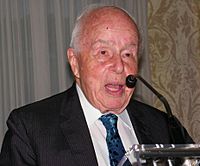Rolf Noskwith facts for kids
Quick facts for kids
Rolf Noskwith
|
|
|---|---|

Rolf Noskwith, seen here in August 2012,
in Halifax, Nova Scotia, Canada. |
|
| Born | 19 June 1919 |
| Died | 3 January 2017 (aged 97) |
| Nationality | British |
| Alma mater | Trinity College, Cambridge |
| Occupation | Soldier, entrepreneur |
| Years active | 1941–2016 |
| Known for | Cryptography and business |
| Board member of | Charnos |
| Children | 1 |
Rolf Noskwith (born June 19, 1919 – died January 3, 2017) was a British businessman. During World War II, he worked as a codebreaker at Bletchley Park. This was a secret British military base where codes were broken. He worked with famous people like Alan Turing.
Contents
Early Life and Education
Rolf Noskwith's parents, Chaim and Malka, were Jewish and came from Eastern Europe. They started a clothing company in Germany. When things became difficult in Germany, they sold their business. In 1932, they moved to England with their children.
In England, the family started a new clothing company called Charnos. This company became a big part of Rolf's life after the war. Rolf went to Nottingham High School and later studied at Trinity College, Cambridge.
Serving in World War II
At first, Rolf was not allowed to join the military. He tried three times. His first try to become a codebreaker was turned down. This was because he was born and grew up in Germany.
However, the rules changed in May 1941. This allowed him to join the effort. He was accepted to work as a translator and codebreaker at Bletchley Park.
Working at Bletchley Park
Rolf Noskwith arrived at Bletchley Park in June 1941. He was interviewed by important people like C.P. Snow. He worked in a special building called Hut 8. His main job was to break codes from the German navy's Enigma machine.
From 1941 to 1945, he helped to read secret messages. These messages were sent by the German navy, known as the Kriegsmarine. He also worked on other types of secret codes. Rolf was very good at finding patterns in coded messages.
One of Rolf Noskwith's biggest achievements was breaking the Naval Enigma's "Offizier" settings. He used a method called a "crib". A crib is a guess about what part of a coded message might say.
Rolf guessed that some letters might be 'EEESSSPATRONE'. This word referred to special color codes. German ships used these codes to tell if other ships were "friend or foe". His guess was then tested by special computers called "bombes".
When his crib worked, it was a huge success. It allowed the Allied forces to read secret German messages. These messages were sent between German navy officers. This helped the Allies greatly during the war.
Rolf remembered that most people at Bletchley Park used first names. But two people were different. Alan Turing was called "Prof". Another person, F.A. Kendrick, was known as "Tony".
Later Life and Legacy
After the war, in 1946, Rolf Noskwith started working for Charnos. This was the textile company his father had founded. He became the chairman of the company in 1952. Around the year 2000, he became the non-executive chairman of Charnos plc.
Rolf Noskwith passed away on January 3, 2017, at the age of 97. Many believe he was the last surviving codebreaker from Bletchley Park at that time. After his death, the head of GCHQ (a British intelligence agency) praised Rolf and other Jewish codebreakers. He said their help was "out of all proportion" to the size of the Jewish community in Britain.

